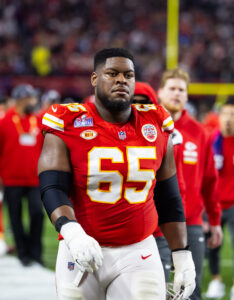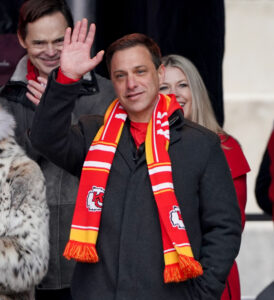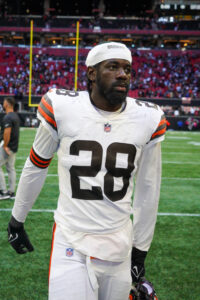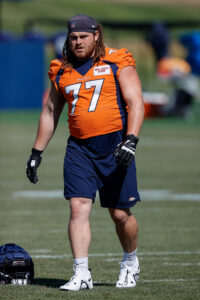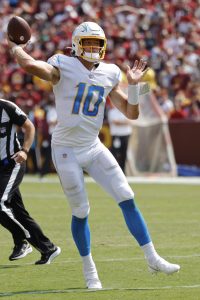Barely a month remains before the 49ers can begin extension talks with Brock Purdy, the Mr. Irrelevant find that helped bail the franchise out of the predicament the Trey Lance miss created. Purdy has lost two of his top four weapons, and he has picked up a shoulder injury. Though, San Francisco’s third-year starter has still accounted himself fairly well in this de facto platform year.
 Purdy’s seventh-round contract runs through 2025, and the 49ers have the leverage of a potential 2026 franchise tag at their disposal. But the expectation has been for Purdy extension talks to begin soon. Where those go will be one of the 2025 offseason’s central storylines, as the 49ers — after Deebo Samuel‘s 2022 trade request, Nick Bosa‘s 2023 holdout and Brandon Aiyuk‘s rumor-flooded hold-in — are set to have another offseason dominated by a big-ticket contract.
Purdy’s seventh-round contract runs through 2025, and the 49ers have the leverage of a potential 2026 franchise tag at their disposal. But the expectation has been for Purdy extension talks to begin soon. Where those go will be one of the 2025 offseason’s central storylines, as the 49ers — after Deebo Samuel‘s 2022 trade request, Nick Bosa‘s 2023 holdout and Brandon Aiyuk‘s rumor-flooded hold-in — are set to have another offseason dominated by a big-ticket contract.
The question that will define the 49ers’ offseason, as well as the organization’s longer-term outlook, centers around where these negotiations will end up. Dak Prescott used extraordinary leverage to drive the quarterback market to $60MM per year, representing a staggering increase based on where the NFL was just five years prior. It took 25 years for the QB market to balloon from $5MM AAV to $25MM AAV; it has since taken just six for it to climb from $30-$60MM per year. At some point, a team will pass on a monster QB payment. The 2024 offseason did not feature any such actions.
Despite neither Trevor Lawrence nor Jordan Love having established themselves as top-tier quarterbacks, each matched Joe Burrow‘s then-record $55MM AAV. Tua Tagovailoa‘s injury history and inconsistent first two seasons made him a curious extension candidate. Despite rumblings of the Dolphins being leery of paying the going rate, they ultimately did, authorizing a $53.1MM-per-year payday for their southpaw starter. It no longer requires sufficient credentials to earn a top-market QB contract. The leverage the position’s importance creates — amid the fear of starting over — drives these negotiations, putting Purdy in strong position.
Purdy, 25 this month, needed to beat out Nate Sudfeld for the 49ers’ third-string job during his first training camp. Lance’s subsequent ankle injury bumped him to the QB2 role, and San Francisco’s offense — to the surprise of most — did not slow down after Jimmy Garoppolo‘s foot fracture. Purdy proved competent and piloted the team to the 2022 NFC championship game. He then made it back by Week 1 after UCL rehab, during an offseason that ended with the 49ers admitting defeat on Lance, whom they traded to the Cowboys for a fourth-round pick.
 Purdy took significant steps last season, throwing 31 touchdown passes in 16 games and becoming the first passer to start a full season and average 9.6 yards per attempt since the 1950s. He led the NFL in QBR and passer rating. The 49ers’ four-All-Pro skill-position cadre provided a considerable boost for the formerly unappealing prospect, but Purdy finished last season by going toe-to-toe with Patrick Mahomes in Super Bowl LVIII. He has been at the wheel longer than Love and has offered more stability than Lawrence. That $55MM-per-year price, then, makes sense as a clear floor.
Purdy took significant steps last season, throwing 31 touchdown passes in 16 games and becoming the first passer to start a full season and average 9.6 yards per attempt since the 1950s. He led the NFL in QBR and passer rating. The 49ers’ four-All-Pro skill-position cadre provided a considerable boost for the formerly unappealing prospect, but Purdy finished last season by going toe-to-toe with Patrick Mahomes in Super Bowl LVIII. He has been at the wheel longer than Love and has offered more stability than Lawrence. That $55MM-per-year price, then, makes sense as a clear floor.
Of course, persistent Purdy skepticism has come from his place in Kyle Shanahan‘s scheme and whether he would be worth such a contract. After all, the team did find Purdy in Round 7. Wouldn’t it be within the realm of possibility for the franchise to consider cashing out via trade (at some point) and believing it could maximize another passer lacking elite skills? Then again, that is a dangerous game to play.
The 49ers being the team to strongly consider passing on authorizing such a contract should not be ruled out, seeing as Shanahan reached a Super Bowl with Garoppolo at the helm. The 49ers would also see their roster blueprint change wildly if/once they pay Purdy. How the team proceeds with its host of contract-year starters in 2025 — a group including Charvarius Ward, Dre Greenlaw, Talanoa Hufanga and Aaron Banks — may be an early tell on how it will proceed with Purdy, as paying the QB — even in the expected event of a backloaded structure that kept cap hits low early — would naturally lead to cost-cutting moves elsewhere on the roster.
Purdy sits seventh in QBR despite Aiyuk and Christian McCaffrey missing most of the season. The Iowa State alum still ranks fourth in Y/A (8.4) and has delivered 275 rushing yards — far more than he offered in 16 games last year. He is on the cusp of receiving the biggest raise in NFL history, as the seventh-round deal averages $934K per annum. 49ers CEO Jed York pointed to the team already planning for a Purdy payday, and while rumblings about a Kirk Cousins trade serving as a potential fallback option (thus reuniting he and Shanahan, Washington’s OC at the time the veteran was drafted) have surfaced, nothing serious has come out regarding any real considerations of separating from Purdy.
With the exception of Prescott, Cousins and Lamar Jackson, high-end QB paydays in the fifth-year option era commence before or during the player’s contract year. QB tags are rare. The 49ers could keep Purdy at a $1.1MM base salary next season and prepare for a 2026 tag at roughly $45MM, but they then run the risk of the market rising down the road. It can also be argued the market might not change much in 2025, as the 2021 and ’22 draft classes have not brought extension candidates. Lawrence has already been paid, with the other four first-round QBs from 2021 not being in line for monster pacts. The 2022 early-round crop has been even worse, with Purdy the only extension candidate to come from that disappointing QB draft.
 The NFL’s $50MM-per-year club expanded to nine this offseason, and Josh Allen will be a candidate to eclipse Prescott’s contract perhaps as early as 2025. The MVP frontrunner does not carry the contractual leverage Prescott did, in being tied to his $43MM-per-year accord through 2027, but the Bills will need to address this team-friendly deal at some point. Allen’s six-year deal is as close as any QB has come to accepting team-friendly terms in line with Mahomes’. The three-time Super Bowl MVP is still signed through 2031 at $45MM per, giving the Chiefs tremendous flexibility. But his peers have, as expected, still opted for shorter-term deals that would allow for more prime-years paydays.
The NFL’s $50MM-per-year club expanded to nine this offseason, and Josh Allen will be a candidate to eclipse Prescott’s contract perhaps as early as 2025. The MVP frontrunner does not carry the contractual leverage Prescott did, in being tied to his $43MM-per-year accord through 2027, but the Bills will need to address this team-friendly deal at some point. Allen’s six-year deal is as close as any QB has come to accepting team-friendly terms in line with Mahomes’. The three-time Super Bowl MVP is still signed through 2031 at $45MM per, giving the Chiefs tremendous flexibility. But his peers have, as expected, still opted for shorter-term deals that would allow for more prime-years paydays.
Barring Purdy accepting Mahomes- or Allen-level terms, the 49ers will need to pay up and make sacrifices elsewhere. That would stand to impact their loaded (when healthy) roster. That will mark a significant change for the franchise, though the team already had Garoppolo on top-market (at the time) terms and still churned out winning squads. San Francisco’s Shanahan-era blueprints have come with and without a veteran-QB deal on the payroll.
Starting over at quarterback would represents a massive risk, and for a team that missed badly when trying to do so (Lance) earlier this decade, it might not be one to take. Purdy has proven effective in Shanahan’s offense, putting him on the cusp of the NFL’s latest quarterback megadeal. How it comes together will shape the market for future passers.
Given how disappointing most of the other arms from the 2021 and ’22 drafts have been, Purdy suddenly resides as the QB market’s centerpiece player for the 2025 offseason. While the 49ers are no strangers to contract drama, it currently appears more likely than not they will stay the course and not become the team that refuses to pay a passer the going rate. Purdy’s asking price topping Prescott’s may change that, but a deal between the Lawrence-Love level and where the Cowboys’ leverage-fueled QB raised the market is probably something the 49ers will need to stomach.
